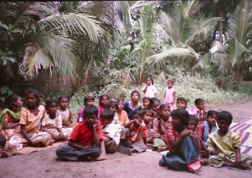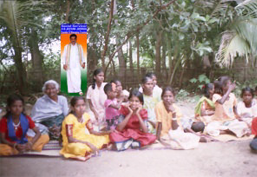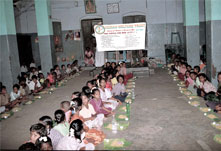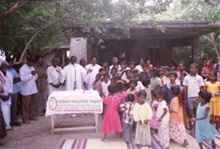Child Labour Awareness Program
Child labour refers to the employment of children in any work that deprives children of their childhood, interferes with their ability to attend regular school, and that is mentally, physically, socially or morally dangerous and harmful. This practice is considered exploitative by many international organisations. Legislations across the world prohibit child labour.

These laws do not consider all work by children as child labour; exceptions include work by child artists, supervised training, certain categories of work such as those by Amish children, and others.Human welfare trust (NGO) have been working to eradicate child labour in India as aimed to reduce child labour irrespective of gender, religious and social background. The Human welfare trust main aim is to enhance the quality of life of children and youth increased knowledge and skills. The trust also realized that merely imparting would help the younger generation come up their life. Creating awareness on abolition of child labour will make some changes among parents and society to think. The youth need to be taught vocational training in school itself to uplift their status. They should be able to stand on their feet and provide for their families after they complete education. We have been planning to start vocational training program for the youth and women in future. This year 20000 handbills and bit notices were distributed among public to impart the important of education for children and youth.
Causes of child labour
Primary causes
International Labour Organisation (ILO) suggests poverty is the greatest single cause behind child labour. For impoverished households, income from a child’s work is usually crucial for his or her own survival or for that of the household. Income from working children, even if small, may be between 25 to 40% of these household income. Other scholars such as Harsch on African child labour, and Edmonds and Pavcnik on global child labour have reached the same conclusion.
Cultural causes
In European history when child labour was common, as well as in contemporary child labour of modern world, certain cultural beliefs have rationalised child labour and thereby encouraged it. Some view that work is good for the character-building and skill development of children. In many cultures, particular where informal economy and small household businesses thrive, the cultural tradition is that children follow in their parents’ footsteps; child labour then is a means to learn and practice that trade from a very early age. Similarly, in many cultures the education of girls is less valued or girls are simply not expected to need formal schooling and these girls pushed into child labour such as providing domestic services.
Macroeconomic causes
Biggeri and Mehrotra have studied the macroeconomic factors that encourage child labour. They focus their study on five Asian nations including India, Pakistan, Indonesia, Thailand and Philippines. They suggest that child labour is a serious problem in all five, but it is not a new problem. Macroeconomic causes encouraged widespread child labour across the world, over most of the human history. They suggest that the causes for child labour include both the demand and the supply side. While poverty and unavailability of good schools explain the child labour supply side, they suggest that the growth of low paying informal economy rather than higher paying formal economy is amongst the causes of the demand side. Other scholars too suggest that inflexible labour market, size of informal economy, inability of industries to scale up and lack of modern manufacturing technologies are major macroeconomic factors affecting demand and acceptability of child labour.



Child labour laws and initiatives
Almost every country in the world has laws relating to and aimed at preventing child labour. International Labour Organisation has helped set international law, which most countries have signed on and ratified.
According to ILO minimum age convention (C138) of 1973, child labour refers to any work performed by children under the age of 12, non-light work done by children aged 12–14, and hazardous work done by children aged 15–17. Light work was defined, under this Convention, as any work that does not harm a child’s health and development, and that does not interfere with his or her attendance at school.This convention has been ratified by 135 countries.
Action against Child Labour in India
India has a legialtion against child labour since 1986 which instead of preventing child labour, allows work by children in non-hazardous industry. Social activist Hemant Goswami had moved the courts against this particular provision and for the failure of the Government to prevent violation of child rights and widespread child labour, his efforts against exploitation of children has forced the government to constitute Commission for Child Right in the State of Harayana, Punjab and Chandigarh. On 9 April 2013, the Punjab and Haryana High Court gave landmark order on the writ-petition (PIL CWP 2693 of 2010) moved by Hemant Goswami. The court, accepted all the contentions and suggestions put forward by Hemant Goswami (who argued the case in-person) and directed that;
There shall be total ban on the employment of children up to the age of 14 years, be it hazardous or non-hazardous industries.
There shall be no forced labour even for children between the age of 14 years to 18 years; and whenever a child above the age of 14 years is forced to work, it has to be treated as an offence under Section 374 IPC and it is to be dealt with sternly.
When any matter is brought to the notice of the State Commission (or for that matter suo motu cognizance taken by the State Commission) involving violation of child rights even where a child above the age of 14 year is employed, the State Commission under the CPCR Act will have the jurisdiction to deal with the same and pass necessary directions.
The violators have to be dealt with effectively and in a speedy manner. Therefore, wherever violations are found, cases under the provisions of Part-IV of the Child Labour Prohibition Act have to be registered without delay in each and every case.
Wherever the officers fail or neglect to take effective action immediately, apart from taking necessary disciplinary action, action can also be taken, in appropriate cases, under Section 166 IPC against such officers.
There is also a need for rehabilitation of such children in the society. (Schemes suggested by Hemant Goswami were adopted by the Court (As Court’s directions), with the following main points;
(a)Moving out the child from the exploitative environment
(b)Ensuring Education
(c)Ensuring Food/Meals/Clothes/ Necessities
(d)Penalty/Compensation should be for the benefit of the Child
(e)Regular Monitoring)
The Chairperson of “State Commissions for Protection of Child Rights” should be a person who has been Judge of the High Court and the process of selection of the other six members of the “State Commissions for Protection of Child Rights” should entail issuance of public advertisement for inviting applications, interviewing eligible candidates and recommending a penal of names of suitable persons.
THe state of Punjab and Haryana as well as U.T., Chandigarh shall also ensure that the State Commissions become fully functional by appointing Chairpersons and Members.
Children’s Courts with specialised infrastructure be created.The above order by the High Court is considred a landmark in “Child Right Protection” in India, as the court declared many existing provisions of the 1986 Indian Child Labour legislation as illegal and against the Constitution of India.
